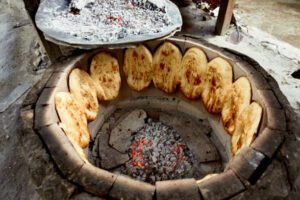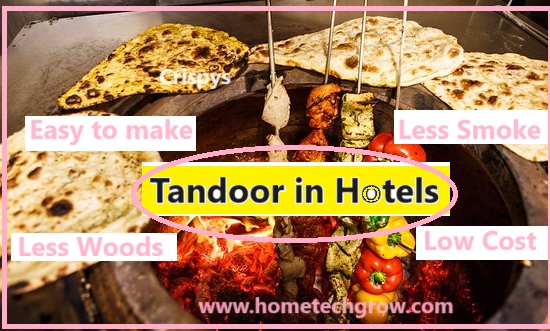Introduction to Tandoor Oven
- A tandoor oven is a traditional and iconic cooking appliance used in many parts of the world, particularly in South Asia, the Middle East, and Central Asia.
- It is renowned for its ability to produce delicious and distinctive dishes, and it holds a special place in the culinary traditions of these regions.
- In this introduction, we will explore the key features and uses of the tandoor oven.
Origins and History
- The tandoor oven has a long and rich history, dating back thousands of years.
- It is believed to have originated in the region that is now modern-day India, Pakistan, and Afghanistan.
- The word “tandoor” is derived from the Persian word “tannūr,” which means “oven” or “hearth.”
- Over the centuries, the tandoor has become an integral part of the culinary heritage of many cultures.
Construction and Design
- Tandoor ovens are typically constructed as cylindrical, vertically-standing ovens.
- They are made from various materials, including clay, terracotta, or metal.
- The key design features of a tandoor include:
- A wide, round opening at the top for inserting food.
- Thick walls that can withstand high temperatures.
- A conical or dome-shaped interior to facilitate even heat distribution.
- Insulation to retain heat efficiently.

Cooking Method:
- The hallmark of tandoor cooking is the intense heat generated inside the oven.
- To use a tandoor, charcoal or wood is burned inside, creating temperatures that can exceed 900°F (480°C).
- The food is cooked by direct exposure to the radiant heat and the hot walls of the oven.
- This high heat results in quick cooking and imparts a unique smoky flavor to the dishes.
Culinary Uses:
Tandoor ovens are incredibly versatile and are used to prepare a wide range of dishes, including:
- Tandoori Bread: Various types of bread, such as naan and roti, are cooked on the inner wall of the tandoor, resulting in a soft and slightly charred texture.
- Tandoori Meats: Marinated meats like chicken, lamb, and fish are skewered and roasted in the tandoor, creating tender and flavorful dishes known as tandoori kebabs.
- Tandoori Vegetables: Vegetables like bell peppers, tomatoes, and potatoes are also roasted in the tandoor, often accompanied by a flavorful marinade.
- Tandoori Paneer: Paneer, a type of Indian cheese, can be marinated and cooked in the tandoor for a smoky and aromatic flavor.
Cultural Significance:
- Tandoor cooking goes beyond the preparation of food; it is deeply ingrained in the cultural fabric of the regions where it is used.
- It is associated with celebrations, gatherings, and communal meals, making it a symbol of hospitality and togetherness.
- The unique flavor and texture achieved through tandoor cooking have made it a beloved part of the local cuisine.
- In recent years, there has been a growing awareness of the environmental impact of our daily activities, including our choices in cooking methods.
- Traditional tandoor ovens you can get in market, while renowned for their culinary prowess, typically use wood or charcoal as fuel, contributing to deforestation and air pollution.
- Tandoors come in various types, each with its unique features, cooking methods, and applications.

Types of Tandoors
- There are many types of tandoors. At the point when the word baked comes up, a great many people consider the well-known Indian chicken formula “roasted chicken”
- Square Tandoor.
- Gas Tandoor.
- Dirt Tandoor Oven
- Drum Tandoor
- Here are some of the most common types of tandoors:
Traditional Clay Tandoor
- Description: The classic tandoor is made of clay and has been in use for centuries in South Asia and the Middle East.
- Construction: It is a cylindrical oven with an inner lining of clay. The heat source, typically charcoal or wood, is placed at the bottom.
- Cooking Method: Food is cooked by skewering it onto metal rods and placing it inside the tandoor. The intense heat cooks the food quickly, giving it a smoky flavor.
- Applications: Used for cooking a wide range of dishes, including Tandoori Chicken, Naan, Roti, and various kebabs.
Metal Tandoor:
- Description: A modern alternative to clay tandoors, metal tandoors are typically more portable and easier to maintain.
- Construction: Made from stainless steel or other heat-resistant metals, they are often insulated to retain heat efficiently.
- Cooking Method: Similar to traditional tandoors, food is skewered and placed inside the metal tandoor for cooking.
- Applications: Suitable for home kitchens, food trucks, and small restaurants.
Gas Tandoor:
- Description: Gas tandoors are designed for convenience and are often used in commercial kitchens.
- Construction: They are equipped with gas burners that provide a consistent heat source.
- Cooking Method: Food is skewered or placed on grates and cooked using the gas flame.
- Applications: Ideal for restaurants and catering services that require a more controlled and consistent cooking process.
Electric Tandoor:
- Description: Electric tandoors are compact and easy to use, making them suitable for home kitchens.
- Construction: These tandoors are powered by electricity and have heating elements that provide even heat distribution.
- Cooking Method: Food is placed on racks or skewers inside the electric tandoor and cooked using electricity.
- Applications: Primarily used for preparing Tandoori dishes at home.
Wood-Fired Tandoor:
- Description: These tandoors use wood as the primary fuel source, imparting a distinct smoky flavor to the dishes.
- Construction: Similar to traditional clay tandoors but designed specifically for wood burning.
- Cooking Method: Food is cooked on skewers or grates using the heat generated by burning wood.
- Applications: Commonly found in traditional and rustic settings, providing an authentic smoky flavor to dishes.
Portable Tandoor:
- Description: Portable tandoors are compact and designed for outdoor cooking.
- Construction: They are often made from stainless steel and are easy to assemble and disassemble for transport.
- Cooking Method: Food is skewered or placed inside the portable tandoor and cooked using charcoal, wood, or gas.
- Applications: Used for outdoor gatherings, picnics, and camping trips.
Hybrid Tandoor:
- Description: Hybrid tandoors combine different fuel sources, such as gas and charcoal, to provide flexibility in cooking methods.
- Construction: These tandoors are designed with both gas burners and a charcoal compartment.
- Cooking Method: Cooks have the option to use gas for convenience or charcoal for the authentic smoky flavor.
- Applications: Ideal for restaurants that want versatility in their tandoor cooking.
Biomass Tandoor
- A biomass tandoor, also known as a bio-tandoor, is a sustainable and eco-friendly version of the traditional tandoor oven.
- This is more suitable for rural areas using various biomass sources as presented in the post.
- It is designed to use biomass fuels as an alternative to wood or charcoal.
- Biomass refers to organic materials derived from plant sources, which can include wood chips, sawdust, agricultural residues, and even recycled food waste.
- By using these renewable and environmentally friendly fuel sources
- a biomass tandoor reduces its carbon footprint and minimizes the negative environmental impacts associated with traditional tandoor cooking.
How to select the Best Tandoor Oven for a Restaurant
- Selecting the best tandoor oven for a restaurant is a crucial decision, as it can significantly impact the quality and flavor of the dishes you serve.
- The choice will depend on factors like the menu, space, budget, and personal preferences.
- Here are some of the best tandoor ovens for restaurant use, catering to various needs and preferences:
Scope of Traditional Clay Tandoor Oven:
- Advantages:
- Renowned for their ability to impart an authentic smoky flavor to dishes, these tandoors are preferred for traditional Indian and Middle Eastern cuisine.
- Considerations:
- They require more maintenance, take longer to heat up, and can be challenging to clean.
- Ideal For:
- Restaurants specializing in traditional Tandoori dishes, kebabs, and Naan bread.
Metal Tandoor Oven:
- Advantages: Easier to maintain and clean than clay tandoors. They heat up quickly and are durable.
- Considerations: May not provide the same smoky flavor as clay tandoors.
- Ideal For: Restaurants that prioritize convenience and versatility, offering a wide range of Tandoori and grilled dishes.
Gas Tandoor Oven:
- Advantages: Offers precise temperature control, making it easier to manage consistent cooking. Convenient and suitable for high-demand restaurant settings.
- Considerations: May not provide the same smoky flavor as wood or charcoal tandoors.
- Ideal For: Busy restaurants, especially those with a varied menu that requires precise cooking temperatures.
Wood-Fired Tandoor Oven:
- Advantages: Imparts a rich, smoky flavor to dishes, making it an excellent choice for authentic and traditional cuisine.
- Considerations: Requires more effort to maintain the wood-burning process and may have longer heat-up times.
- Ideal For: Restaurants specializing in traditional Tandoori dishes and outdoor dining experiences.
Hybrid Tandoor Oven:
- Advantages: Offers the flexibility to switch between gas and charcoal/wood, providing convenience and flavor versatility.
- Considerations: Higher initial cost due to dual fuel options.
- Ideal For: Restaurants that want both convenience and the option to infuse smoky flavors into their dishes.
Custom-Built Tandoor Oven:
- Advantages: Tailored to meet specific restaurant needs, including size, design, and fuel type.
- Considerations: Higher cost and longer lead times for construction.
- Ideal For: Restaurants with unique requirements or those seeking a signature cooking style.
Biomass Tandoor
- a biomass tandoor is a sustainable and eco-friendly cooking solution that combines the rich culinary heritage of tandoor cooking with environmentally responsible practices.
- Whether used in a restaurant or at home, it allows for the enjoyment of delicious Tandoori and grilled dishes while minimizing the environmental impact of cooking.
- Here are some key features and benefits of a biomass tandoor:
1. Sustainability:
- Biomass fuels are renewable resources, meaning they can be replenished naturally through the growth of plants and trees.
- This contrasts with the unsustainable harvesting of wood for traditional tandoors, which contributes to deforestation and habitat destruction.
2. Reduced Carbon Emissions:
- When organic matter is burned, it releases carbon dioxide (CO2) into the atmosphere.
- However, because the plants absorbed CO2 from the atmosphere during their growth, burning biomass creates a carbon-neutral or even carbon-negative cooking process when managed sustainably. This helps combat climate change.
3. Improved Air Quality:
- Traditional tandoors that use wood or charcoal emit harmful particulate matter and pollutants into the air, contributing to air pollution and respiratory issues.
- Biomass tandoors produce fewer pollutants, resulting in improved air quality.
4. Cost Savings:
- Biomass fuels are often more affordable and readily available than wood or charcoal, making biomass tandoors a cost-effective choice for both commercial and residential users.
5. Versatility:
- Biomass tandoors can be used to cook a wide variety of dishes, just like traditional tandoors.
- They are versatile and can accommodate various types of cuisine, from Tandoori specialties to grilled and roasted items.
6. Energy Efficiency:
- Many biomass tandoors are designed with insulation and efficient combustion systems, which can lead to energy savings and reduced fuel consumption.
7. Sustainable Business Practices:
- Using a biomass tandoor can be seen as a commitment to sustainable and eco-friendly business practices, appealing to environmentally conscious customers.
Challenges and Considerations:
Conclusion
- In summary, the tandoor oven is a time-honored and cherished cooking appliance that has left an indelible mark on the culinary traditions of various cultures.
- Its ability to produce mouthwatering dishes with a distinctive smoky flavor continues to make it a beloved and essential tool in kitchens worldwide.
- When choosing a tandoor oven for your restaurant, consider factors such as menu specialization, cooking volume, available space, budget, and the level of expertise among your kitchen staff.
- Additionally, consult with reputable tandoor suppliers or manufacturers who can provide guidance on selecting the best option to meet your restaurant’s specific needs.
- Ultimately, the right tandoor oven will enhance the authenticity and quality of your restaurant’s Tandoori cuisine.
